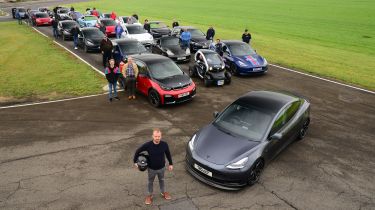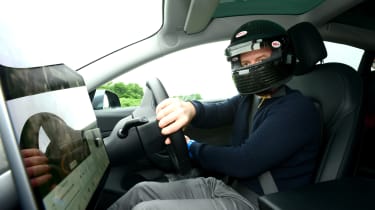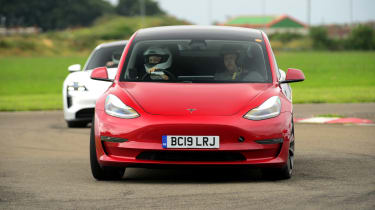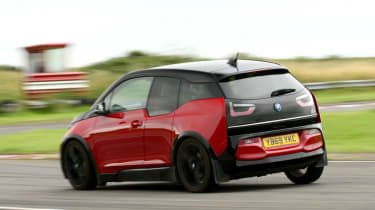Electric car track day: are EVs fun to drive?
We headed down to Wales to experience a track day with a difference as electric cars drive round the Llandow circuit
Electric cars are better than combustion-powered cars. There, we’ve said it. Line up any battery-charged vehicle with the equivalent petrol or diesel version, and you’ll find it smoother and easier to drive, as well as much quieter and generally more refined.
As well as finishing any drive feeling more relaxed, electric cars produce zero emissions as they go, and there’s an overwhelming amount of data that shows that, even when tracing the materials back to their source, they’re still the cleanest, most efficient option we currently have for personal transportation. And recent times have shown us that it’s hard to panic buy electricity – especially if you can charge from home and draw power from renewable sources.
EVs are quick, too, in a specific way. The latest Tesla Model S Plaid has three motors and more than 1,000bhp, which helped it lap the Nürburgring Nordschleife in seven minutes 35.579 seconds. Impressive in isolation, but compare it with some other four and five-door combustion alternatives and you’ll wonder what the fuss is about. The new Audi RS 3 saloon, complete with five-cylinder turbocharged petrol engine, beat that time by a few hundredths of a second, yet costs a third of the price. Porsche’s most extreme SUV, the Cayenne Turbo GT, is quicker, and the Alfa Romeo Giulia Quadrifoglio, despite having almost precisely half the power, beat it by three seconds. And its driver set that benchmark in a T-shirt.
But with more and more driver-focused EVs hitting the market every year, it’ll only be a matter of time before there’s a wealth of battery-powered cars that we’ll want to take on track. The time to show what that future could look like is now, according to John Chambers, who has organised the UK’s first-ever, EV-only track day at Llandow circuit, just down the road from Cardiff. We went along to see if it might transform the future track day landscape, or if there’s still some resistance to overcome.
John is a former self-confessed petrolhead. He’s had an involvement in motorsport since the eighties, when he developed timing systems for Richard Lloyd Racing and its privateer Porsche 956 and 962 racers for the World Sportscar Championship. Through a series of other motorsport-based ventures – including a driver-coaching business that used video analysis (when it had to be achieved with VHS recorders) to help motorists improve their technique – he eventually stumbled towards EVs. Like many die-hard motorsport fans, his first impressions of electric cars were rather sceptical.
“I started to see what Tesla was doing with the [original Lotus Elise-based] Roadster and the Model S, and I thought that was all a bit of a gimmick! At the time my own cars were fast petrol cars, so I couldn’t ever see me getting into that,” he says. But perhaps unsurprisingly for someone whose motorsport background involved working closely with pure lap times, it was the figures that really turned his head.
“When Tesla announced the Model 3, I could see that was going to be a game changer,” he added. “I took the snap decision in 2016 to put a deposit down without seeing the full specs. And as we had to wait several years longer than America for first deliveries, we could start to see that there was a little group of people in the States that were using it for whatever motorsport they could enter, and it turned out to be performing very well. So that got me back into thinking about cars on track.”
That turned John towards developing upgrades for his own Model 3 (more on which later) even before it arrived, and also to get EVs in general more accepted into grassroots UK motorsport. And so we come to this track day, a proof of concept that, not only can EVs be safe and fun on a track, but that’s there’s a suitable demand from owners.
As it turned out, a healthy 24 cars arrived for the event, an impressive turnout for a first attempt. While you might expect a current e-track day to be a long string of Teslas, with the occasional Audi e-tron GT and Porsche Taycan thrown in for good measure, that didn’t prove to be the case. There was a genuinely eclectic and unlikely mix of vehicles on show. A BMW i3 S, a Volkswagen e-Golf and even a Renault Twizy were brought along to be put through their paces.
With EV conversions of combustion classics set to become an ever-growing part of the automotive landscape, it was refreshing to see one such example here. An early Porsche Boxster, converted by one-man operation Neville Payne for a Porsche-loving client, sported a Tesla Model S rear motor paired to a 17kWh battery from a Vauxhall Ampera.
When we arrive in the morning, the process is much like any other track day. You sign up, have a little chat with your fellow drivers, before a briefing where everyone gets a gentle reminder to encourage keeping their levels of ambition below their talent. There is one difference in the build up, however; there’s no need to worry if any of the cars attending will pass Llandow’s noise regulations.
Once on the go, it feels like any other track day. Except for the noise, of course. There’s a wide range of ability of drivers in cars of various speeds, but aside from the track day equivalent of fingernails on a chalkboard (scrubbing front tyres in a chicane) the morning passes without incident.
Indeed, John’s primary trade fits in neatly with the track day brief. He runs TEVO Solutions; a company that develops and supplies turning upgrades for Tesla owners.
As the action continued, we took the opportunity to take a look around John’s upgraded Model S before venturing out on the circuit. Having taken his Model 3 Performance out on the road and several track days at Brands Hatch, it was clear that there were some areas that needed improvement.
The first was the braking system. The reliance on regenerative braking on the road means that the standard discs and pads really struggle to keep up on track. Big AP Racing discs and calipers are paired with higher-friction pads to address this. Various suspension upgrades, including Ohlins coilovers and adjustable control arms also feature, as do a super-sticky set of Michelin Pilot Cup 2 Tyres. Initially developed for John’s own car, TEVO Solutions sells these upgrades to other Tesla drivers.
They’re all upgrades that really help to unlock the Model 3’s savage acceleration and turn it into an entertaining track car. YouTube viewers will recognise Llandow as the place where our man Steve Sutcliffe performs many of our track battles. It’s short but with a couple of technical sections, and an abrasive surface that isn’t kind to tyres; even more so when many of the cars are close to the two-tonne mark.
While the standard car pitches under acceleration and rolls through the turns, the TEVO stays flat, controlled and agile through the tight bus stop section, allowing you to get on the power far earlier. The brakes are consistent, powerful and don’t even hint at fading after repeated hard stops. Even the tyres hold up reasonably well considering the abrasive surface. It’s all very, very accomplished. Are we missing the satisfaction of nailing manual shifts and a glorious engine note? Yes. But are we still having fun? Absolutely.
Our laps took us to the lunch break, which revealed that one aspect of EV ownership which needs improvement. As many owners will confirm, it’s not the cars themselves that need work, but the infrastructure. Driving any car on a race track uses a lot of energy, be it the fossil or electrical variety, which means top-ups aren’t unusual in the middle of an event like this. But while petrol stations are commonplace for drivers and a quick five-minute fill is all that’s needed before going back on track, that process becomes a little more tricky and time-consuming for EV owners.
Yet there is a glimmer of hope for those with electric cars. As EVs become more popular on events like this, it’s not beyond the realms of possibility that circuit owners will install chargers on site, meaning drivers could top up at any time during the day without even leaving the premises.
It’s a big investment, but there are ways to encourage circuits to both improve their infrastructure and spread knowledge of EVs in general.
“I’ve been in discussion with one circuit about running EVs on the driving-experience days,” says John. “This would be a perfect chance for an EV-charger supplier to put in charging points at the circuit. But it does need the growth of the infrastructure in this country to help this along. Even if the chargers are just outside the circuit, it will be a massive improvement over what we have now at most tracks.”
John points out other hurdles, too, some of which come down to a lack of education about the electrical systems. “I’ve been to some circuits where marshals have told me that, if I beach it in the gravel, they won’t come near me!” he explains. Yet John says this training is coming, citing Thruxton in Hampshire in particular as a venue that’s well versed in dealing in EVs, especially after it hosted Mission Motorsport’s record-breaking hypermiling run in a Renault Zoe back in June. “It’s definitely starting to happen,” he adds. “It has to change, so I want to make sure we don’t wait to be forced to change, and to be proactive about it.”
There are some practical advantages, too, with John pointing at experience from his most recent outing at Brands Hatch in Kent. “There were lots of red flags in the morning; none of them due to EVs,” he says. “In fact, they were all a result of oil being left down on the circuit!”
So can EV track days work? Based on our experience, absolutely, especially once those changes take place. We don’t see the future for events like this being exclusively electric; indeed, if combustion cars eventually become legislated off the road, this might be one of the few places to still experience the sounds and the smells of classic performance cars. But one thing that we can promise is that it doesn’t matter what powers your model, driving to a car’s and your own abilities away from the confines of speed-limited public roads will always be a thrill.
Click here for our list of the best electric cars on sale right now...
Find a car with the experts








